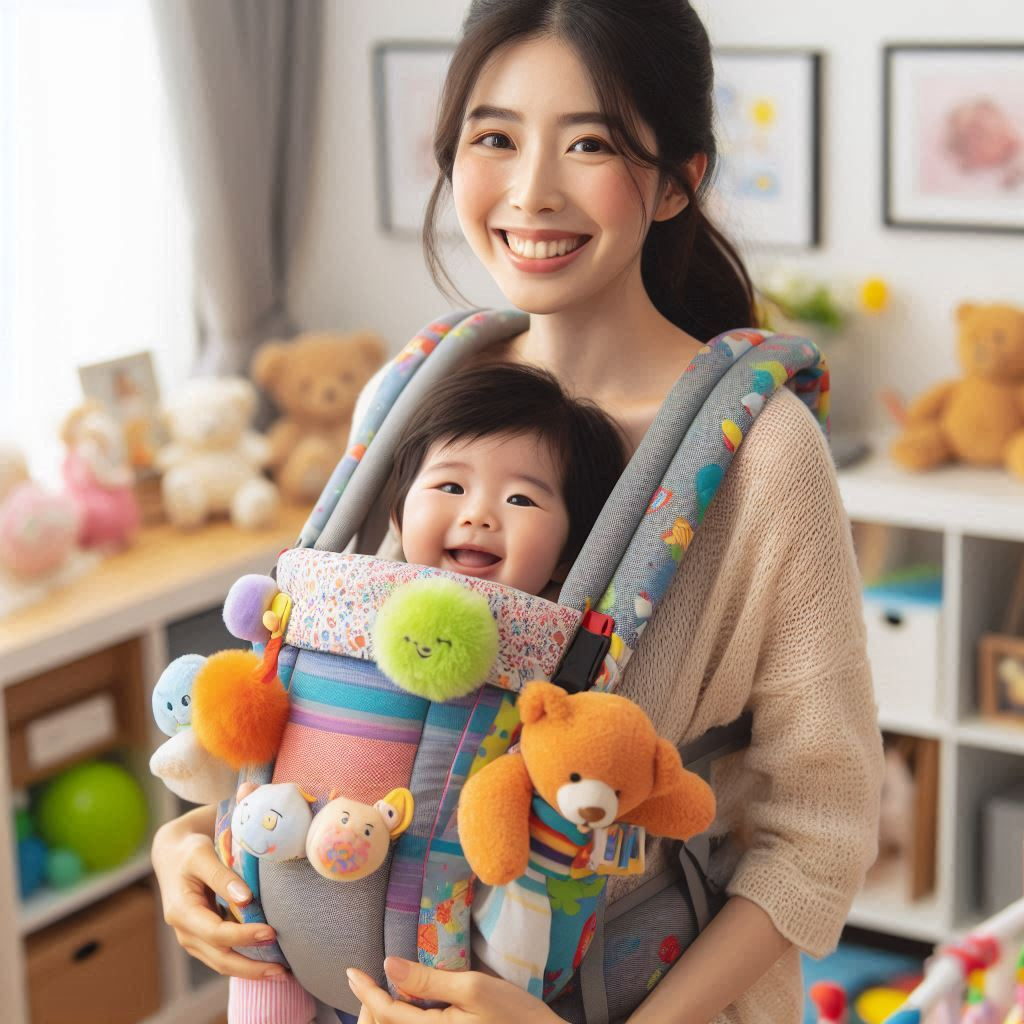When to Use a Baby Carrier?
Are you a new parent wondering when to use a baby carrier? You’re not alone! Many moms and dads find themselves asking this question as they navigate the early days of parenthood. Baby carriers can be a game-changer, but knowing the right times to use them is key.
Quick answer: Use a baby carrier from birth to toddlerhood for everyday tasks, outings, soothing fussy babies, and promoting bonding. It’s ideal for hands-free movement during chores, walks, shopping, travel, and outdoor activities.
My Journey with Baby Carriers: A Personal Story

Before we dive in, let me share a little story from my own experience. When my daughter Emma was born, I was overwhelmed with all the new responsibilities. One day, while trying to do laundry with a crying baby in my arms, I remembered the baby carrier I’d gotten as a shower gift.
“I fumbled with the straps, feeling a bit silly, but once I got Emma snuggled in, it was like magic. She stopped crying, I had my hands free, and for the first time in weeks, I actually finished the laundry!”
That moment changed everything for me. I went from feeling stuck at home to confidently running errands, taking walks, and even enjoying coffee with friends – all with Emma snug against my chest. It wasn’t just about getting things done; it was about feeling like myself again while still being there for my baby.
Benefits of Using a Baby Carrier
Let’s talk about why baby carriers are so great:
- Bonding: Keeping your baby close helps you connect and understand their needs better.
- Hands-free movement: You can do chores, shop, or care for other kids while carrying your baby.
- Comfort for baby: Many babies love the snug feeling, which reminds them of the womb.
- Easier breastfeeding: Some carriers make it possible to nurse discreetly on the go.
- Less crying: Studies show that babies carried for several hours a day cry less in the evening.
When to Use a Baby Carrier: Age by Age Guide
Newborns (0-3 months)
Newborns love being held close, and carriers can help you do this while still getting things done. Here’s when to use a carrier with your newborn:
- During “witching hour”: Many newborns get fussy in the evening. Carrying them can help soothe them.
- For skin-to-skin contact: This is great for bonding and can help regulate baby’s temperature and breathing.
- While doing light housework: Fold laundry, load the dishwasher, or prepare simple meals.
- On gentle walks: Get some fresh air and light exercise while keeping baby close.
Remember: Always make sure your newborn’s airways are clear and their head is supported.
Infants (3-12 months)
As your baby grows, you’ll find even more times when a carrier comes in handy:
- While shopping: Navigate stores easily without a bulky stroller.
- At social gatherings: Keep baby close and comfortable in new environments.
- During travel: Carriers are great for airports, public transport, and exploring new places.
- For naps on the go: Many babies sleep well in carriers, letting you keep moving.
Toddlers (12-36 months)
Yes, you can still use a carrier with your toddler! Here’s when it might be useful:
- On hikes or long walks: When little legs get tired, a carrier can save the day.
- In crowded places: Keep your toddler safe and close at fairs, markets, or busy streets.
- During tantrums: Sometimes, being held close can help calm an upset toddler.
- For bonding time: Even big kids need cuddles!
Choosing the Right Carrier
With so many options out there, picking a carrier can feel overwhelming. Here’s a quick guide:
Types of Carriers
- Wraps: Long pieces of fabric you tie around yourself and baby. Great for newborns but can have a learning curve.
- Soft-structured carriers: These have buckles and straps, like a backpack. Easy to use and good for longer wearing times.
- Ring slings: A piece of fabric that goes over one shoulder and is adjusted with rings. Quick to put on but may not be as comfortable for long periods.
- Mei tais: A mix between wraps and soft-structured carriers. Versatile and adjustable.
What to Look For
When choosing a carrier, consider:
- Comfort: Look for wide, padded straps and good back support.
- Ease of use: If it’s too complicated, you might not use it often.
- Weather-appropriate: Consider breathable fabrics for summer and cozy options for winter.
- Adjustability: A carrier that grows with your baby is a great investment.
- Your body type: What works for one person might not be comfortable for another.
Safety First: Tips for Using Baby Carriers
While carriers are generally safe, it’s important to use them correctly:
- Check the T.I.C.K.S.:
- Tight
- In view at all times
- Close enough to kiss
- Keep chin off chest
- Supported back
- Practice: Try using the carrier with a doll or stuffed animal first.
- Start small: Begin with short periods and work up to longer wearing times.
- Listen to your body: If you’re uncomfortable, your baby probably is too.
Real Talk: When Not to Use a Baby Carrier
While carriers are amazing, there are times when it’s best to skip them:
- During high-energy activities: No jogging or biking with baby in a carrier.
- When cooking: Hot stoves and sharp knives are too risky.
- If you’re very tired: Safety first – put baby down if you’re exhausted.
- In cars: Always use a proper car seat, never a carrier.
Babywearing Around the World
Did you know that babywearing isn’t a new trend? It’s been practiced in many cultures for centuries. Here are some interesting facts:
- In some African countries, babies are carried in colorful wrapped cloths called kanga or kitenge.
- Mexican rebozo wraps serve as both a baby carrier and a fashion accessory.
- In Japan, the onbuhimo carrier allows for a high back carry, perfect for petite caregivers.
These traditions show us that babywearing isn’t just practical – it’s a beautiful way to honor cultural heritage and keep babies close.
Dealing with Common Concerns
Even with all the benefits, some parents worry about using carriers. Let’s address some common concerns:
“Will my baby become too clingy?”
Research actually shows that babies who are carried tend to be more independent as they grow. The security they feel allows them to explore with confidence later on.
“Is it bad for my baby’s hips?”
When used correctly, carriers support healthy hip development. Look for carriers that allow a “M” position of the legs, with knees higher than the bottom.
“What if I can’t figure out how to use it?”
Don’t worry! There are lots of resources available. Many areas have babywearing groups where you can get hands-on help. Online tutorials can also be useful.
Wrapping It Up: The Joy of Babywearing
Using a baby carrier isn’t just about convenience (though that’s a big plus!). It’s about connection, freedom, and enjoying your baby while still being you. Whether you’re soothing a fussy newborn, exploring a new city with your curious infant, or giving a tired toddler a lift on a nature walk, carriers can enhance your parenting journey in so many ways.
Remember, there’s no one “right” way to use a carrier. What matters is finding what works for you and your baby. So go ahead, give it a try! You might just find, like I did, that it opens up a whole new world of possibilities.
Your Next Steps
- Research different types of carriers to find what might work best for you.
- If possible, try on a few carriers before buying. Many baby stores offer this option.
- Start with short periods of wearing at home to get comfortable.
- Join a local babywearing group (online or in-person) for support and tips.
Have you tried using a baby carrier? What was your experience like? Share your stories and tips in the comments – your insights could really help another parent just starting out on their babywearing journey!

Jessica Winter is a passionate parenting blogger with two years of experience guiding new and seasoned parents through the joys and challenges of raising babies. Her insightful posts blend personal anecdotes with expert advice to offer a warm and practical perspective on modern parenting.

